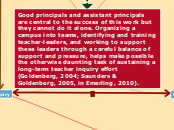Good principals and assistant principals are central to the success of this work but they cannot do it alone. Organizing a campus into teams, identifying and training teacher-leaders, and working to support these leaders through a careful balance of support and pressure, helps make possible the otherwise daunting task of sustaining a long-term teacher inquiry effort (Goldenberg, 2004; Saunders & Goldenberg, 2005, in Emerling, 2010).
Problem Solving
Ill-Structured
Need to teach
21st Century Jobs
Well-Structured
Commonly taught
Collaboration
Frame Problem based on Inquiry Question
Evidence Based
Reflect on Evidence
Implement Solution(s)
Share
Repeat Cycle
Self-Regulated
Proactive
Goal Directed
Strengths
Feedback
Next Steps
Repeat Cycle
Self-Monitored
Inquiry
Free Choice
Risk
Reward
Questions
Solve Problem
Improve Learning
Motivation - balanced extrinsic & intrinsic
Self-Efficacy
What steps can you take to create an environment where educators engage in a cycle of collaborative inquiry?
Ermeling, B. A. (2010). Tracing the effects of teacher inquiry on classroom practice. Teaching and Teacher Education, 26(3), 377-388. doi:10.1016/j.tate.2009.02.019
Inquiry Focused Protocol
Job-alike Teams
Distributed Leadership
Facilitators
